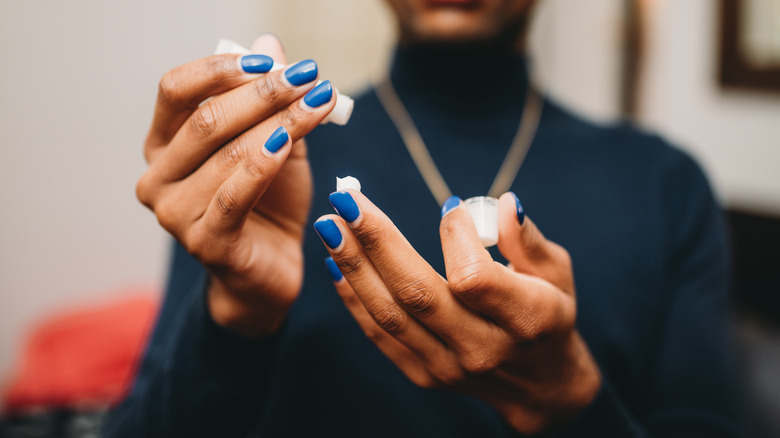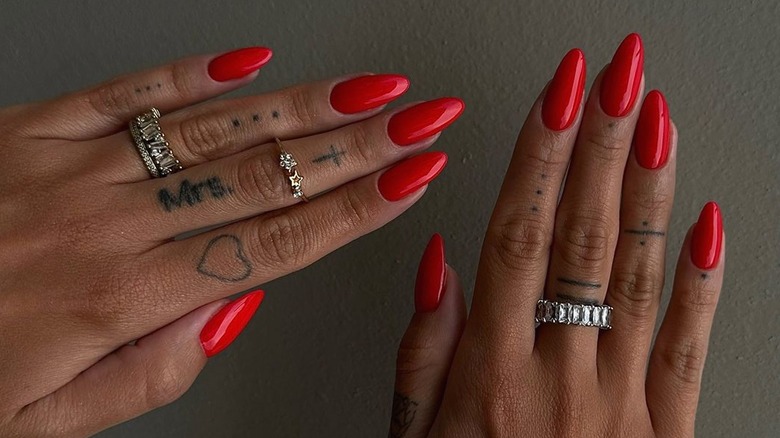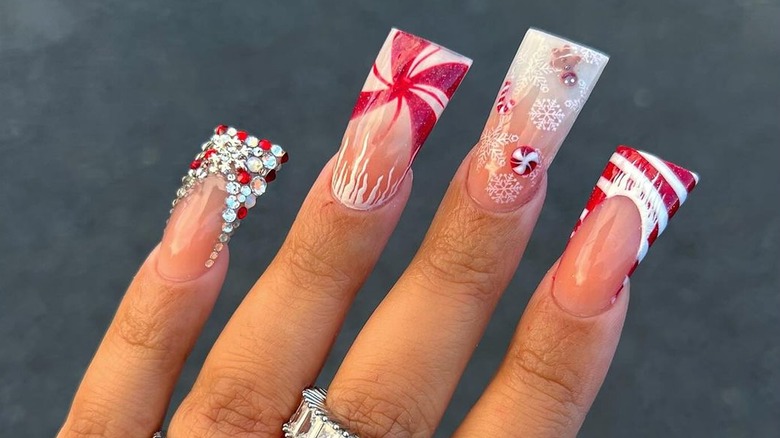Why It's So Important To Keep Up With Nail Care During The Winter
We all know it can be important to change up our skincare routines in the winter to beat dry skin caused by the temperature change outside, but did you know your nails may need a little extra help in the winter, too? Yep, it's true. Though you'd be forgiven for thinking your nails can take a bit of a backseat in the winter because they tend to be covered up by things like fluffy socks, winter boots, or gloves, it's super important you don't ignore your nails as one year ends and another begins.
In fact, it turns out that our nails can get extra dehydrated in the winter, just like our skin can. "With the change in weather, the winter season can be harsh on nails," Mavala nail care expert Lynn Mason explained. "The exposure to cold weather can cause nails to dry out and become brittle. Due to the lack of moisture, nails can become too hard and cause them to break easily." And Deborah Lippmann, founder of her own eponymous nail line, agreed. "The exposure to the elements not only dries out the nails but may cause them to flake. Our nails naturally have a low oil and moisture content and therefore, they can become dry and brittle," she told Glamour. And that makes nail care in the winter just as, if not more, important than during the other seasons.
Nails may actually need more moisturizing in the winter
With so many of us needing to turn to a thicker moisturizer for our face and hands in the winter, it's also worth doing a little something extra for our nails. As we already know, the winter can dry them out because there's naturally less moisture in the air, which is why they may need a little more care than the rest of the year. Lynn Mason recommended to Mavala that when the weather turns colder, you should start stepping up your game with cuticle oil. If you already use a cuticle oil throughout the year, you may want to apply a little more or put it on more regularly over the winter. But if you tend to rely on hand products throughout the year, winter may be the time to incorporate a nail oil. That's because Mason explained that oil will get deeper into the skin than some creams or lotions, and can even help encourage your nails to grow stronger. And, speaking of lotions, nail expert Skyy Hadley recommended swapping them for creams in the winter, as creams offer more moisture.
Another pro tip for the winter? Hand masks! "The weather is cooler during party season, leading to [an increased amount of] dry skin on our hands and cuticles. I would recommend a hand mask or treatment to rehydrate your hands and nails," manicurist Maddi Dogra told Vogue India.
Fungal nail infections can still develop in the winter
Dr. Shari Lipner noted to Today that nail problems like fungal nail infections don't just happen in the summer, and not keeping up with your nail routine could only exacerbate the issue. Fungal nail infections actually occur because the fungi causing the issue develops best in warm and moist environments. Though we tend to think of that happening in the summer when our feet or sweating in the summer sun, in reality, in the winter, our feet tend to be wrapped up a little more. Those who live in locations that get cold in the winter may be warming up next to cozy fires in warm fluffy socks or hitting the streets in winter boots, all of which are designed to keep the feet toasty.
Dr. Lipner recommended that anyone who notices anything that appears to be a fungal nail infection should get in contact with a dermatologist over the winter. That's because leaving the problem until the summer could only make it worse or mean you won't feel like walking around with your summer sandals due to unsightly nails.
Popular winter nail polish shades can cause staining
Another reason to keep up with nail care during the winter? Sometimes, winter nail trends can dictate wearing shades that can stain the nails — and one of the biggest offenders is red. Seeing as red is the color of the holidays, so many of us apply layers of it in winter, only to take it off and notice our talons are yellow underneath (consider us guilty). As for why? "Our nail plates are made of layers of keratin which are super porous, and the [nail polish] pigments can wedge in there over time," nail artist Sigourney Nuñez explained to Byrdie.
That's why you want to still care for your nails properly to stop staining. The first step you can take is to apply a base coat to create a barrier before the polish and your nails. But if it's too late and your nails have already yellowed, then there are ways you can help remove it. "Drop three [denture tablets] into a bowl of lukewarm water, and let your fingers soak for five minutes," nail artist Miss Pop recommended to Allure. You could also try applying cuticle remover to the nail for around one minute. "This, along with a gentle nail buff for natural nails, will lighten yellow staining," Miss Pop shared. NailKnowHow founder, Julie Ventura, even recommended soaking your fingertips in a mixture of one tablespoon of white vinegar and one cup of warm water for 10 to 15 minutes.
While seasonal nail art can also take its toll
Not only do many of us sport red nails over the winter, but it can also be the time to be a little bolder with our nails. That can mean applying things to our nails we usually wouldn't for that big holiday party (consider us guilty again). "We tend to add a little more drama to our nails over party season. Typically, extensions are wanted, glitter, art, and embellishments are most requested," Maddi Dogra explained to Vogue India. And that can potentially spell some bad nail news. "As gorgeous as this makes our nails look, a file or 'buff' is required to [be used on] our natural nail for the gel or acrylic to adhere to, leaving our natural nail below slightly weakened," Dogra said.
Not only can all that buffing pre-manicure not be great for the nails, but it can also impact our talons again when it comes off. Soft gel nails have to be soaked off using acetone, while hard gel has to be removed with a nail drill. That's why it may be better over the winter to try and go for a regular polish (if you can) which can be removed without the need for acetone. That's because, as Lynn Mason told Mavala, acetone can dry out the nail. Not what you want when they're already battling the elements — which is why keeping up with your nail care is super important in the winter.




